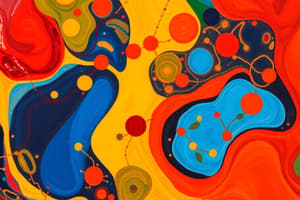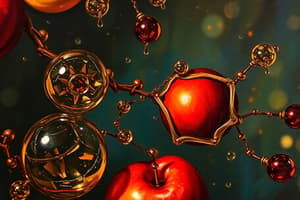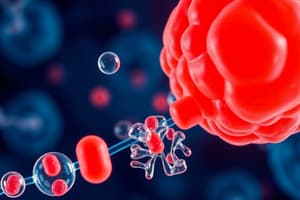Podcast
Questions and Answers
Which of the following is NOT a category of nonsaponifiable lipids?
Which of the following is NOT a category of nonsaponifiable lipids?
- Carotenoids
- Triglycerides (correct)
- Steroids
- Prostaglandins
The basic structure of steroids is the ______.
The basic structure of steroids is the ______.
ciclopentanoperhidrofenantreno
Steroids are directly related to triglycerides, phospholipids, and sphingolipids.
Steroids are directly related to triglycerides, phospholipids, and sphingolipids.
False (B)
Which of the following is NOT a major type of steroid?
Which of the following is NOT a major type of steroid?
What is the common name for the steroid that is a crystalline substance insoluble in water?
What is the common name for the steroid that is a crystalline substance insoluble in water?
What is the nickname for LDL?
What is the nickname for LDL?
What are the functions of the hormones produced by the adrenal cortex?
What are the functions of the hormones produced by the adrenal cortex?
Match the following eicosanoids with their roles:
Match the following eicosanoids with their roles:
Eicosanoids are derived from fatty acids with 20 carbon atoms.
Eicosanoids are derived from fatty acids with 20 carbon atoms.
What is the structural feature that differentiates different prostaglandin families?
What is the structural feature that differentiates different prostaglandin families?
Which of these statements about terpenes is accurate?
Which of these statements about terpenes is accurate?
Which of these is NOT a type of fat-soluble vitamin?
Which of these is NOT a type of fat-soluble vitamin?
Humans can produce all the fat-soluble vitamins they need.
Humans can produce all the fat-soluble vitamins they need.
What are the main functions of vitamin A?
What are the main functions of vitamin A?
What is the primary function of vitamin D?
What is the primary function of vitamin D?
What is the main role of Vitamin E in the body?
What is the main role of Vitamin E in the body?
What is the primary role of Vitamin K in the body?
What is the primary role of Vitamin K in the body?
Flashcards
Steroids
Steroids
Lipids that are structurally unrelated to triglycerides, phospholipids, and sphingolipids, typically containing 17 carbon atoms.
Sterols
Sterols
A category of steroids, including cholesterol.
Cholesterol
Cholesterol
A crystalline, water-insoluble sterol, crucial for many bodily functions.
LDL
LDL
Signup and view all the flashcards
Hormones
Hormones
Signup and view all the flashcards
Eicosanoids
Eicosanoids
Signup and view all the flashcards
Prostaglandins
Prostaglandins
Signup and view all the flashcards
Tromboxanes
Tromboxanes
Signup and view all the flashcards
Leucotrienes
Leucotrienes
Signup and view all the flashcards
Carotenoids
Carotenoids
Signup and view all the flashcards
Vitamin A
Vitamin A
Signup and view all the flashcards
Vitamin D
Vitamin D
Signup and view all the flashcards
Vitamin E
Vitamin E
Signup and view all the flashcards
Vitamin K
Vitamin K
Signup and view all the flashcards
Bile acids
Bile acids
Signup and view all the flashcards
Terpenes
Terpenes
Signup and view all the flashcards
Arachidonic Acid
Arachidonic Acid
Signup and view all the flashcards
Liposoluble Vitamins
Liposoluble Vitamins
Signup and view all the flashcards
Adrenal Cortex
Adrenal Cortex
Signup and view all the flashcards
Cortisol
Cortisol
Signup and view all the flashcards
Androgens
Androgens
Signup and view all the flashcards
Study Notes
Lipids Not Saponifiable
- Lipids not saponifiable include: Steroids, prostaglandins, leucotrienes, thromboxanes, carotenoids, and lipid vitamins.
- Steroids are not related to triglycerides, phospholipids, or sphingolipids; they share a basic structure of 17 carbon atoms.
- Important steroids include: sterols, bile acids, female and male sex hormones, corticosteroid hormones, and vitamin D.
- Cholesterol is a well-known sterol. It is a crystalline substance insoluble in water.
- LDL ("bad cholesterol") is a low-density lipoprotein that transports cholesterol to cells.
Steroid Hormones
- Adrenal cortex hormones stimulate glycogen synthesis and fat breakdown, and affect protein metabolism
- Cortisol is a stress hormone
- Androgens (e.g., testosterone) and estrogens/progesterone affect sexual development and function.
Eicosanoids
- Prostaglandins, leukotrienes, and thromboxanes are eicosanoids derived from 20-carbon fatty acids (primarily arachidonic acid).
- Prostaglandins are crucial in various physiological processes, including regulating blood pressure, blood clotting, and inflammation.
- Prostaglandins were first isolated from the prostate, and are found in all tissues.
- They play crucial roles in medicine and pharmacology.
- Prostaglandins influence blood pressure and blood circulation.
Leukotrienes
- Leukotrienes are involved in various inflammatory responses and allergic reactions.
Thromboxanes (TX)
- Thromboxanes are powerful metabolites of prostaglandins that stimulate platelet aggregation and vasoconstriction.
Carotenoids
- Carotenoids are pigments that give color to foods.
- They are insoluble in water and are a source of vitamin A.
Vitamins (Lipophilic)
- Vitamins A, D, E, and K are fat-soluble vitamins.
- Vitamin A is vital for vision and growth, derived from carotenoids.
- Vitamin D regulates calcium and phosphorus absorption, critical for bone formation.
- Vitamin E acts as an antioxidant by preventing premature cell damage.
- Vitamin K is crucial for blood clotting.
Studying That Suits You
Use AI to generate personalized quizzes and flashcards to suit your learning preferences.




